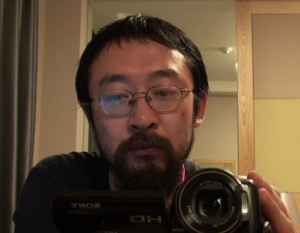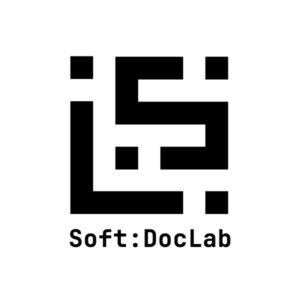
論社會複眼
On Social Compound Eye
2021.11
叢峰 Cong Feng
英文翻譯—劉培安 Liu, Pei-An

叢峰
叢峰,中國獨立紀錄片導演。畢業於南京大學大氣科學系,先後在中國氣象局和《國際先驅導報》工作。印有詩集《那裡有一列我看不見的火車》、《一部雅俗共賞的文學作品謝謝我也這麼認為》。2005年回到甘肅古浪縣黃羊川,開始拍攝系列紀錄片“甘肅的意大利”,即《信仰》、《馬大夫的診所》和《未完成的生活史》。
One of the concepts that my film work constantly tries to illustrate is the social compound eye.
The evolution and spread of network, social media, and video means have brought about new image relations, making possible an examination that I call the social compound eye. The internet offers the possibility of a participatory social cognition, where the material of reality provided by each individual verifies, complements, and corrects the overall facts by comparing and complementing them with other materials. Along with the death of the author of the great and arbitrary history, small but independent producers and authors of history are born.
我的影像工作不斷試圖闡明的一個概念,是社會複眼。
網路、社交媒體和影像手段的沿革與普及,帶來新的影像關係,使一種考察成為可能,我稱之為社會複眼:網路提供了參與式的社會共同認知的可能,每個個體提供的現實材料通過與其他材料進行比對、互補,來對總體事實進行驗證、補充與修正。伴隨專斷的大歷史作者的死亡,微小但獨立的歷史生產者、作者誕生。
We are soaked and wrapped up in social media and online spaces, and the fragments of reality are constantly being produced online. This is today’s historical archive, today’s historical images that do not decay or fade. In a sense, history has become the eternal presence, permanently present. The way memories are produced and stored have encountered a great change. We have to respond to new historical materials and new ways of producing historical memory. We cannot wait for history to pass before studying it because history has never been a mummy as a static object. In order to examine the great changes of today, it is necessary to turn from the archaeology of the past to the archae(now)
我們被社交媒體和網路空間所浸透和包裹,網路中的現實片段在源源不斷地生產出來,這就是今天的歷史檔案,今天的歷史影像,不腐朽也不褪色。在某種意義上,歷史已經成為永遠的現在式,永久在場。記憶的生成與儲藏方式發生了巨變,我們要對新的歷史材料和新的歷史記憶生產方式做出回應,不能等待歷史過去之後再去研究歷史,因為歷史從來不是作為靜態物件的木乃伊。為了考察今日之巨變,要從考察過去的考古學(Archaeology)轉向考察今天的考現學 archae(now)
Cyberspace has become an interface for writing, sharing and storing real information and historical memories─ a platform. Through the production and uploading of real images, sounds, and texts, each person can post a recorded fragment of a microscopic, or even large, historical event. This makes possible a “symmetrical anthropology” in Latour’s sense: an explanation of the equality of power. People do not need an external other to interpret their own situation – from being described to self-description and self-historical production, from following the only grand historical narrative to producing an autonomous perspective.
網路空間成了書寫、分享、儲存現實資訊與歷史記憶的一個介面─平臺。通過生產與上傳現實影像、聲音、文本,每個人都可以發佈微觀的、乃至大的歷史事件中一個被紀錄的片段。這使得拉圖爾意義上的「對稱性人類學」成為可能:闡釋權力的平等。人們不需要一個外在的他者就可以闡釋自己的境遇——從被描述到自我描述和自我歷史生產,從遵從唯一的大歷史敘事到生產自主的觀點。
正因為網路給人以現實無比豐富的感覺,它同樣成為偽造現實的流通處,這些作為扭曲鏡像的贗品取代和遮蔽現實,進而被視為現實,作為景觀得以傳播。
Just as the Internet gives the impression of an incomparable richness of reality, it also serves as a circulation point for counterfeited reality, where these fakes, as distorted mirrors, replace and obscure reality, and are then perceived as reality and disseminated as a landscape.
We know from our own experience that the “memory” behavior of individuals is by no means objective, nor is the memory behavior of society. By the time it is presented to us, most of the historical and social memory material has already been intermediate, which is inevitable, but we have to ask: is it the social compound eye that has carried out the intermediated-relayed, or did the social compound eye undergo distortion? In the latter invisible rigged process, what kind of processing is done to the signal and what kind of noise is added to it?
我們從自身經驗知道,個體的「記憶」行為絕非客觀,社會的記憶行為同樣如此。在呈現給我們的時候,大多數歷史和社會記憶材料已經被中介化了——中介化在所難免,但我們要問:是社會複眼進行了中介—中繼,還是社會假眼進行了失真化處理?
在後者不可見的黑箱過程中,信號做了何種處理,加入了何種噪音?
The social compound eye is not a vision formed by the organism’s own organs; instead, it is a manipulated vision that works by stealing the subjectivity of the masses. When false and counterfeited social memory is implanted in the individual’s historical consciousness in the form of collective acquiescence, this distorted personal memory eventually reinforces the false social memory.
社會假眼不是有機生命體自身器官形成的視覺,是被人為操縱的視像,通過竊取大眾的主體性來起作用。當虛假、偽造的社會記憶以集體默認的面貌被植入個人的歷史意識,這種失真的個人記憶最終又強化了虛假的社會性記憶。
What are the essential changes in today’s image-mediated memory behaviors?
Why is memory so important? –Because memory is about the true continuation of history. The question of how to construct memory (including digital aspect of memory) is equivalent with “how to write history?”.
What is the condition of memory? –The destruction of both memory and history is accelerating.
Through what do we memorize? –That is, what are the materials and tools of social memory?
Is memory based on the real material, or is it a proxy for history? Is it based on nutritious food or hallucinogenic or even deadly poisonous mushrooms?
今天的以影像為媒介的記憶行為發生了何種本質變化?
為什麼記憶如此重要?——因為記憶關乎到歷史的真實續存。如何構築記憶(以及記憶體)的問題也就相當於「如何書寫歷史?」。
記憶的處境是什麼樣的?——記憶和歷史的毀滅都在加速。
通過什麼來記憶?——也就是說,社會記憶的材料和工具是什麼?
記憶是基於真材實料,還是基於歷史的代用品?是基於有營養的食糧,還是致幻甚至致命的毒蘑菇?
The social compound eye is a pre-instrument of social memory, intervening in our “social memory” behavior, acquiring, verifying and detecting material, organizing and organically producing “social viewing”, instead of handing over the gaze to the social spurious eye. The compound eye is no longer an individual, single point of viewing, it is a viewing organized and unified by a multitude of unitary and independent viewing. The microscopic material provided by each unit of the social compound eye (not only images-pictures, but also textual and acoustic) modify and enrich the current historical perception and memory. The materials acquired and identified by the social compound eye become credible sources of memory and constitute the memory of society; otherwise, our memory is only made up of deformed and unreal materials.
社會複眼是社會記憶的前級工具,要對我們的「社會記憶」行為加以干預,進行材料的獲取、驗證和甄別,對「社會觀看」加以有機地組織和生產,而不是把目光交給社會假眼。複眼,已經不是個體的、單一的觀看,它是由眾多單元性的、獨立的觀看組織和統一起來的觀看。各個社會複眼單元提供的微觀材料(不僅限於影像─圖像,也可能是文本的、聲音的),修正並豐富了當下的歷史認知與記憶。經過社會複眼獲取與鑒別的材料,才能成為可信的記憶材料來源,構成社會的記憶體,否則我們的記憶只是由變形的、非本真的材料構成。
The social compound eye is a relay of viewing, a union of gazes that magnifies the primary viewing and recording of individuals step by step. Finally, it forms a social scale of viewing, a “legitimate viewpoint” of social reality and history that can be relied upon and a revealing viewpoint that compounds facts and truths. Without the union of gaze, there is only a single and fragmentary production. The compound eye cannot be formed, and it relies on the publisher- relay and close cooperation of the viewers─ relying on, and ultimately contributes to, the formation of the social nervous center.
社會複眼是觀看的接力,目光的聯合,將個體的初級觀看與記錄逐級放大,最終形成社會尺度的觀看,形成一種可以信賴的關於社會現實與歷史的「正見」,一種複合了事實與真相的具有揭示性的觀點。沒有目光的聯合,只有單一的、碎片式的生成,複眼仍無法形成,它依賴於發佈者─觀看者的接力與密切合作——複眼依賴於、並且最終促成社會神經中樞的形成。
The practice of social compound eye is often spontaneous and instinctive, a new possibility made after the fulfilment of technological conditions. Today, people have developed a subconscious image response to critical situations – pulling out their phones to take pictures and upload them to social media. It is out of a subconscious desire to form a social compound eye – to be seen by as many people as possible. This simple but significant act that constitutes the smallest and most substantial form of resistance. The social compound eye creates and widens the cracks in the landscape, allowing the obscured reality to become visible and spread.
社會複眼的實踐很多時候是自發的、本能的,是技術條件實現後的新可能。今天人們已經養成了對危急情境的下意識影像反應——掏出手機拍攝並上傳社交媒體,這是出於一種形成社會複眼的下意識願望——讓更多人看到。這一舉動簡單但意義非凡,構成了最微小而實質的抵抗。社會複眼在景觀中製造和擴大裂縫,使被遮蔽的現實得以顯現與傳播。
The social compound eye itself is generated in a Gaia-like manner: it consists of an infinite number of equal visual engagements, eventually forming a cybernetic autonomic adjustment- Focusing. In contrast to the inorganic social spurious eye, the social compound eye is a living organism vision that examines itself and makes society aware of its own existence.
社會複眼本身的生成方式是蓋婭式的:它由無數平等的視覺參與構成,最終形成控制論式的自主調節─對焦。和無機化的社會假眼相比,社會複眼是生命體視覺,會審視自身,使社會覺察到自身的存在。
Every public event and disaster today is a testament to the importance of the “social compound eye” formed between the ordinary “a nobody with a camera” with a cell phone and the “us” who are also watching. Everyone can become a unit of the social compound eye.
From Vertov’s “Man with a Movie Camera” to today’s “nobody with a camera and cell phone.”
今天的每一起公共事件,每一個災難,都在證明普通的拿著手機的「持攝像機的無名者」與其他同樣在看的「我們」之間共同形成的「社會複眼」的重要性。人人可以成為社會複眼的一個單元。
From Vertov’s “Man with a Movie Camera” to today’s “nobody with a camera and cell phone.”
From the Vertovian cinematic eye to the social compound eye of today. The social compound eye is the new cinematic eye, the thousand eyes of the masses.
從維爾托夫「持電影攝影機的人」,到今天的「持攝像機、持手機的無名者」。
從維爾托夫式的電影眼,到今天的社會複眼。社會複眼就是新的電影眼,是諸眾的一千隻眼睛。
The social compound eye does not imply a narrow sense of vision, but a social critical vision. As Eisenstein says in “Dickens, Griffith, and Us,” cinema is “the art of perspective-not art of the eye.” Similarly, what makes the social compound eye a social imaging device is not in the sense of optics, but in the sense of a social vision.
社會複眼並不意味著狹義的視覺,而是一種社會性的批判視野。就像愛森斯坦在《狄更斯,格里菲斯和我們》一文中所說的,電影是「觀點的藝術——不是眼睛的藝術。」同樣,使社會複眼成為社會成像裝置,並非是在光學的意義上,是在社會視野的意義上。
The social compound eye of the masses goes against to the social spurious eye of the landscape. The war between the forces represented by these two acts of imagery is the most fundamental war of all─wae-images. War-images, which I use to indicate the ubiquitous situation of war and the intertwined and inseparable images: about the images of war, even image-related and image-taking wars, can be felt in their universality by extending the meaning of war a little. If we are already entwined with images, if cell phones, computers, the Internet, LCD screens, cameras and surveillance are everywhere, and if everyone is becoming a photographer without distinction, then all images will be “war-images” in the future: about images of war (in any sense of the war), images related — the war for scrambling images. The only possibility is to become an “image fighter” and to participate in this war: to criticize cinema in cinema, to criticize images in images. The image that submerges everyday life is itself a component of reality. Today, everyone is a member of the “Fight Club” of images.
諸眾以社會複眼對抗景觀的社會假眼。這兩種影像行為所代表的力量間的戰爭,是最本質的戰爭─影像。戰爭─影像,我用來指示無處不在的戰爭情境和影像的相互裹挾與密不可分:關於戰爭的影像,甚至是與影像相關的、奪取影像的戰爭,只要把戰爭的含義略加延伸,就可以感受到其普遍性。如果我們已經和影像緊緊纏繞在一起,如果手機、電腦、網路、液晶廣告屏、攝像頭和監控無處不在,如果每個人都在無差別地成為拍攝者,那麼未來所有的影像都將是「戰爭─影像」:關於戰爭(無論何種意義上的戰爭)的影像,與影像相關——爭奪影像的戰爭。唯一的可能是成為「影像搏擊者」,參與到這場戰爭中來:在電影中批判電影,在圖像中批判圖像。淹沒了日常生活的影像,自身就是現實的組成部分。如今,每個人都是影像的「搏擊俱樂部」的成員。
Unlike the social spurious eye of the landscape, the social compound eye does not have a “director” or a “scriptwriter”, but a kind of mutual cooperation and practice in an Anarchy style. The social compound eye is an awakened social “vision” that develops its own subjectivity and actively assembles itself. Only through unity can we resist the erosion of social consciousness by the landscape, which uses false history to nibble up live time, and form a solid enough common memory.
不同於景觀的社會假眼,社會複眼沒有「導演」和「編劇」,有的是一種安那其式的互助合作與實踐。社會複眼是覺醒的、發揚自身主體性、主動聯合裝配起來的社會「視覺」。景觀用假歷史來蠶食活時間,諸眾只有通過聯合才能抵禦景觀對社會意識的侵蝕,形成足夠堅固實在的共同記憶體。
